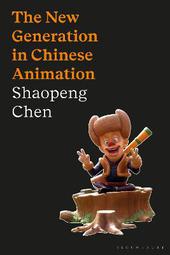
|
The New Generation in Chinese Animation
Hardback
Main Details
| Title |
The New Generation in Chinese Animation
|
| Authors and Contributors |
By (author) Shaopeng Chen
|
| Series | World Cinema |
|---|
| Physical Properties |
| Format:Hardback | | Pages:304 | | Dimensions(mm): Height 234,Width 156 |
|
| Category/Genre | Films and cinema
Digital animation |
|---|
| ISBN/Barcode |
9781350118959
|
| Classifications | Dewey:741.580951 |
|---|
| Audience | | Tertiary Education (US: College) | |
|---|
| Illustrations |
50 bw illus 8 bw charts 3 bw tables
|
|
Publishing Details |
| Publisher |
Bloomsbury Publishing PLC
|
| Imprint |
Bloomsbury Academic
|
| Publication Date |
21 October 2021 |
| Publication Country |
United Kingdom
|
Description
In 1995 Chinese animated filmmaking ceased to be a state-run enterprise and was plunged into the free market. Using key animated films as his case studies, Shaopeng Chen examines new generation Chinese animation in its aesthetic and industrial contexts. He argues that, unlike its predecessors, this new generation does not have a distinctive national identity, but represents an important stage of diversity and exploration in the history of Chinese animation. Chen identifies distinct characteristics of new generation filmmaking, including an orientation towards young audiences and the recurring figure of the immortal monkey-like Sun Wukong. He explores how films such as Lotus Lantern/Baolian Deng (1999) responded to competition from American imports such as The Lion King (1994), retaining Chinese iconography while at the same time adopting Hollywood aesthetics and techniques. Addressing the series Boonie Bears/Xiong Chumo (2014-5), Chen focuses on the films' adaptation from the original TV series, and how the films were promoted across generations and by means of both online and offline channels. Discussing the series Kuiba/Kui Ba (2011, 2013, 2014), Chen examines Vasoon Animation Studio's ambitious attempt to create the first Chinese-style high fantasy fictional universe, and considers why the first film was a critical success but a failure at the box-office. He also explores the relationship between Japanese anime and new generation Chinese animation. Finally, Chen considers how word-of-mouth social media engagement lay behind the success of Monkey King: Hero is Back (2015).
Author Biography
Shaopeng Chen received his PhD degree from University of Southampton, UK, and he is sponsored by the China Scholarship Council (CSC). He holds a MA degree in Animation Arts from Nanjing University of the Arts. China, but his research covers both Chinese animation and live-action Chinese film. He has published articles in Asian Culture and History; East Asian Journal of Popular Culture and New Cinemas: Journal of Contemporary Film. Previously, he taught animation production courses at Nanjing Normal University of Special Education, China.
ReviewsThis is the first book that systematically discusses animated feature film in China after 1995, unraveling the challenges and innovations in its transition to a market-oriented economy. It is an original and timely contribution to Chinese animation studies. A must read for anyone who wants to know contemporary Chinese animation. -- Daisy Yan Du, author of Animated Encounters: Transnational Movements of Chinese Animation 1940s-1970s
|